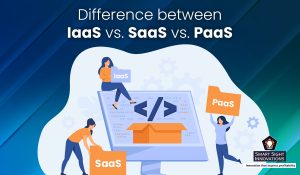 Synopsis: There are three major types of cloud service models – software as a service (SaaS), infrastructure as a service (IaaS) and platform as a service (PaaS). It may take some time to understand the cloud as it is a system that powers the operations of modern technology companies.
Synopsis: There are three major types of cloud service models – software as a service (SaaS), infrastructure as a service (IaaS) and platform as a service (PaaS). It may take some time to understand the cloud as it is a system that powers the operations of modern technology companies.
Learning how to use different cloud computing services to build the technologies you use every day can be of great help.
You want to move to the cloud but aren’t sure what type of service will work best for you. A comparison between the services can guide and help you determine which cloud computing services can best meet your business needs.
IaaS: Infrastructure as a service is used by companies that do not wish to build and maintain their own on-premise data centers. It provides virtual computing resources over the web.
An IaaS cloud vendor hosts the infrastructure components typically present in an on-premises data center, including servers, storage, networking hardware and hypervisor.
SaaS: Software as a service vendors host applications, which makes them available to users via the internet. With SaaS, businesses do not need to install or download any software into their existing IT infrastructure.
So users always get the latest versions of the software. The SaaS provider looks after maintenance and support.
PaaS: Platform as a service provides developers with a platform for software development and deployment over the internet, allowing them to use up-to-date tools. It provides a framework that developers can use to build customized applications.
PaaS cloud vendors manage servers, storage, and networking, while developers manage applications.
Comparison between IaaS, PaaS and SaaS based on multiple factors
Type of services available
IaaS: Virtual machine, operating system, network, storage and backup services.
SaaS: Email, office automation, CRM development, website testing and virtual desktop
PaaS: Service and application testing, development, integration and deployment
The extent of business justification
IaaS: Create a platform for service and application testing and development
SaaS: To carry out business tasks
PaaS: Build and deploy services and applications for users
Level of abstraction
IaaS: Abstraction of underlying hardware resources
SaaS: Complete abstraction
PaaS: The abstraction of the underlying hardware, software, and application services.
Degree of control
IaaS: Minimum degree of control and flexibility
SaaS: the highest degree of control and flexibility
PaaS: Good degree of control and flexibility
Cost of operation
IaaS: Highest
SaaS: Minimum
PaaS: Low
Flexibility mode
IaaS: Best
SaaS: No flexibility
PaaS: Limited flexibility
Possibility of vendor engagement
IaaS: Minimum
SaaS: Highest
PaaS: Medium
Level of security required
IaaS: Compliant with the security policy of the virtual and physical servers.
SaaS: It requires transparency in the service provider’s security policies to determine the degree of sensitive corporate data.
PaaS: Additional security is required to ensure that rogue applications do not exploit vulnerabilities in the software platform.
Type of users
IaaS: System managers
SaaS: Business users
PaaS: Developers & deployers
Popular examples
IaaS: Rackspace, Amazon Web Services (AWS), Microsoft Azure, Google Compute Engine and Magento 1.
SaaS: Netflix, Google Apps, Databox, Dropbox, Salesforce, Cisco, Concur, GoToMeeting and Slack.
PaaS: AWS Elastic Beanstalk, Windows Azure, Force.com, Google App Engine and Apache Stratos.
What works best – IaaS vs. SaaS vs. PaaS?
With cloud services and the best selection, you gain more control over applications and processes, but you need to keep in mind certain factors that have considerable influence. Popularity, infrastructure management, platform, networks and much more decide the best outcomes in cloud computing services.
IaaS vs. SaaS
IaaS is infrastructure and SaaS is about software and applications. IaaS is about managing computing resources in the cloud with servers, hardware, software, networks and other infrastructure components.
SaaS is a software delivery model that allows users to connect to and use cloud-based applications over the internet. In SaaS, software vendors take care of everything for the users while users consume the services which are provided based on a subscription model.
For the maximum amount of control within a cloud environment and to avoid external management data issues that can compromise the functionality or security of your data, IaaS is the best option.
However, if you don’t need as much flexibility and ease of use, it is better to migrate to a smaller-scale SaaS solution.
IaaS vs. PaaS
Infrastructure-as-a-Service gives you a lot of control over your operating system. It is the core of your cloud-computing environment.
On the other hand, with Platform-as-a-Service, you can build apps without hosting them on-premises, so you benefit from more flexibility but with a little less control.
Choosing the best service model depends on the needs of your enterprise. If you want to build a website, an IaaS product like AWS can provide the infrastructure to host the site and its applications.
However, if you want to add custom features, a PaaS product like Google App Engine can host your site and let your developers design and deploy custom application solution.
SaaS vs. PaaS
By now, you already know that Platform-as-a-Service is a way to build new products besides your already existing network. But Software-as-a-service is a step ahead. SaaS products are fully vendor-managed and ready for use by your teams.
Are you wondering when to choose a PaaS product over a SaaS product?
Suppose, you’re looking to build a payroll app that fits your HR needs, Platform-as-a-Service gives you all the tools you need to be successful. The product once finished can be considered SaaS.
IaaS vs. PaaS vs. SaaS – which is more advantageous?
Now, cloud-based services have changed the way businesses operate, allowing them to access IT infrastructure, platforms, software, and applications through the internet and online hotspots.
Organizations that are considering moving their ecommerce business to the cloud, need to be aware of the beneficial aspects of the three major cloud services:
IaaS benefits include:
- It is scalable and ensures that companies have access to all the resources they need when they need them.
- It is faster and more cost-effective for organizations to operate workloads because they do not need to purchase, manage and support the underlying infrastructure.
- Infrastructure-as-a-Service provides a pay-as-you-go approach to storage, networking and virtualization.
SaaS benefits include:
- Organizations can use SaaS products as soon as they subscribe because it is the easiest cloud model to set up and run.
- To add users, organizations simply need to upgrade their existing plans or subscriptions. They do not require purchasing additional server space or software licenses.
- SaaS is also the easiest to maintain as cloud providers manage everything.
- Software-as-a-Service offers the highest degree of vendor management providing complete software solutions.
PaaS benefits include:
- It is convenient as providers offer most of the infrastructure and other IT services for organizations, which users can access from an internet connection and a web browser.
- Supports rapid development with text editing, version management, compiling and testing services, as well as infrastructure that helps developers build new software efficiently.
- They also help the development team work together, regardless of physical location.
- Platform-as-a-Service also provides services such as hardware and software development tools available through the web.
Conclusion
There are various cloud computing services and each is suitable for different businesses and has its pros and cons. You can choose the service that best suits your business needs.
When it comes to selecting a cloud service, knowing the difference between IaaS, PaaS and SaaS will serve as a guide for you in opting for the best-suited service for your organization and its unique requirements.
Also, it’s important to get help when you need it, so look for a provider that provides 24-hour technical support.














